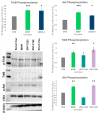Development of Pleiotropic TrkB and 5-HT4 Receptor Ligands as Neuroprotective Agents
- PMID: 38276593
- PMCID: PMC10819171
- DOI: 10.3390/molecules29020515
Development of Pleiotropic TrkB and 5-HT4 Receptor Ligands as Neuroprotective Agents
Abstract
One common event that is the most detrimental in neurodegenerative disorders, even though they have a complex pathogenesis, is the increased rate of neuronal death. Endogenous neurotrophins consist of the major neuroprotective factors, while brain-derived neurotrophic factor (BDNF) and its high-affinity tyrosine kinase receptor TrkB are described in a number of studies for their important neuronal effects. Normal function of this receptor is crucial for neuronal survival, differentiation, and synaptic function. However, studies have shown that besides direct activation, the TrkB receptor can be transactivated via GPCRs. It has been proven that activation of the 5-HT4 receptor and transactivation of the TrkB receptor have a positive influence on neuronal differentiation (total dendritic length, number of primary dendrites, and branching index). Because of that and based on the main structural characteristics of LM22A-4, a known activator of the TrkB receptor, and RS67333, a partial 5-HT4 receptor agonist, we have designed and synthesized a small data set of novel compounds with potential dual activities in order to not only prevent neuronal death, but also to induce neuronal differentiation in neurodegenerative disorders.
Keywords: 5-HT4 receptor; TrkB receptor; neurite differentiation; neurodegeneration; neuronal survival.
Conflict of interest statement
The authors declare no conflict of interest.
Figures










Similar articles
-
Design, synthesis and biological characterization of novel activators of the TrkB neurotrophin receptor.Eur J Med Chem. 2023 Feb 15;248:115111. doi: 10.1016/j.ejmech.2023.115111. Epub 2023 Jan 10. Eur J Med Chem. 2023. PMID: 36645981
-
BDNF mimetic compound LM22A-4 regulates cementoblast differentiation via the TrkB-ERK/Akt signaling cascade.Int Immunopharmacol. 2014 Apr;19(2):245-52. doi: 10.1016/j.intimp.2014.01.028. Epub 2014 Feb 11. Int Immunopharmacol. 2014. PMID: 24530412
-
A Small Molecule TrkB Neurotrophin Receptor Partial Agonist as Possible Treatment for Experimental Nonarteritic Anterior Ischemic Optic Neuropathy.Curr Eye Res. 2018 Dec;43(12):1489-1499. doi: 10.1080/02713683.2018.1508726. Epub 2018 Oct 1. Curr Eye Res. 2018. PMID: 30273053 Free PMC article.
-
Indirect influence on the BDNF/TrkB receptor signaling pathway via GPCRs, an emerging strategy in the treatment of neurodegenerative disorders.Med Res Rev. 2025 Jan;45(1):274-310. doi: 10.1002/med.22075. Epub 2024 Aug 24. Med Res Rev. 2025. PMID: 39180386 Review.
-
Neurotrophic Factor BDNF, Physiological Functions and Therapeutic Potential in Depression, Neurodegeneration and Brain Cancer.Int J Mol Sci. 2020 Oct 21;21(20):7777. doi: 10.3390/ijms21207777. Int J Mol Sci. 2020. PMID: 33096634 Free PMC article. Review.
Cited by
-
Stimulating myelin restoration with BDNF: a promising therapeutic approach for Alzheimer's disease.Front Cell Neurosci. 2024 Sep 2;18:1422130. doi: 10.3389/fncel.2024.1422130. eCollection 2024. Front Cell Neurosci. 2024. PMID: 39285941 Free PMC article. Review.
-
Positive Allosteric Modulators of Trk Receptors for the Treatment of Alzheimer's Disease.Pharmaceuticals (Basel). 2024 Jul 28;17(8):997. doi: 10.3390/ph17080997. Pharmaceuticals (Basel). 2024. PMID: 39204102 Free PMC article. Review.
References
MeSH terms
Substances
Grants and funding
LinkOut - more resources
Full Text Sources
Medical

